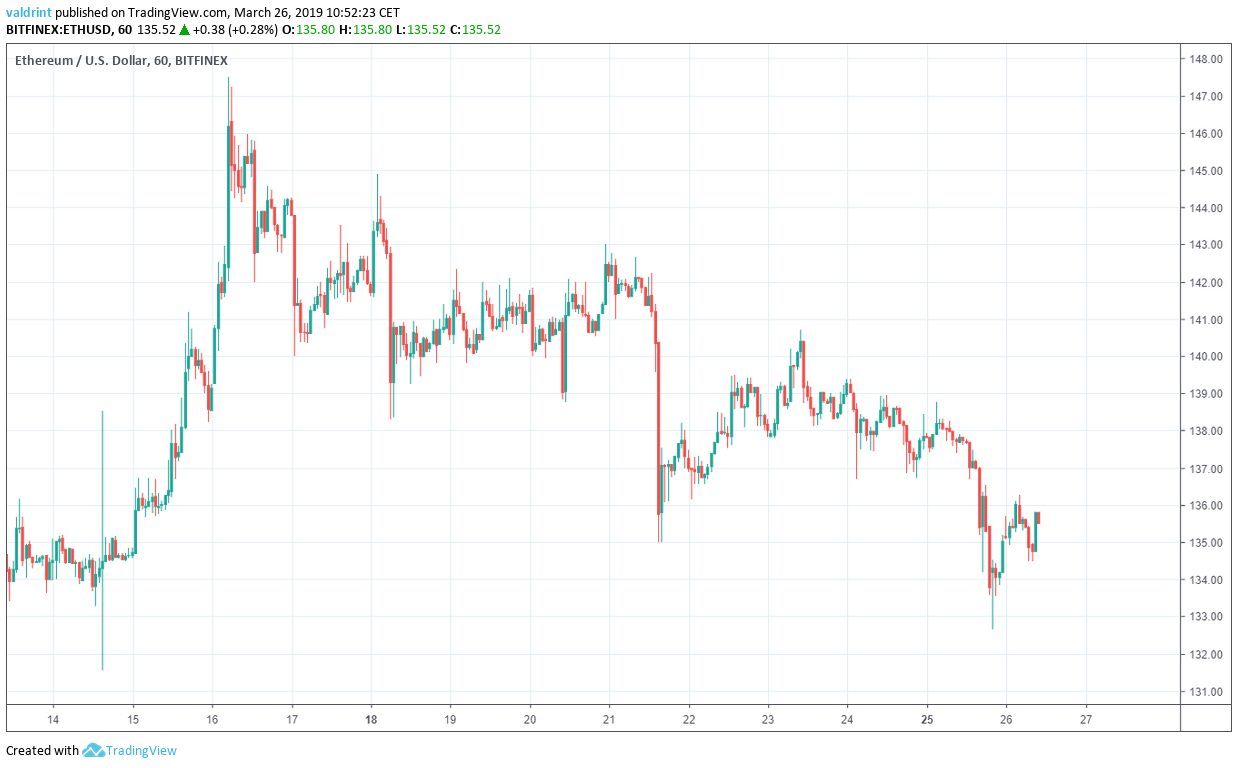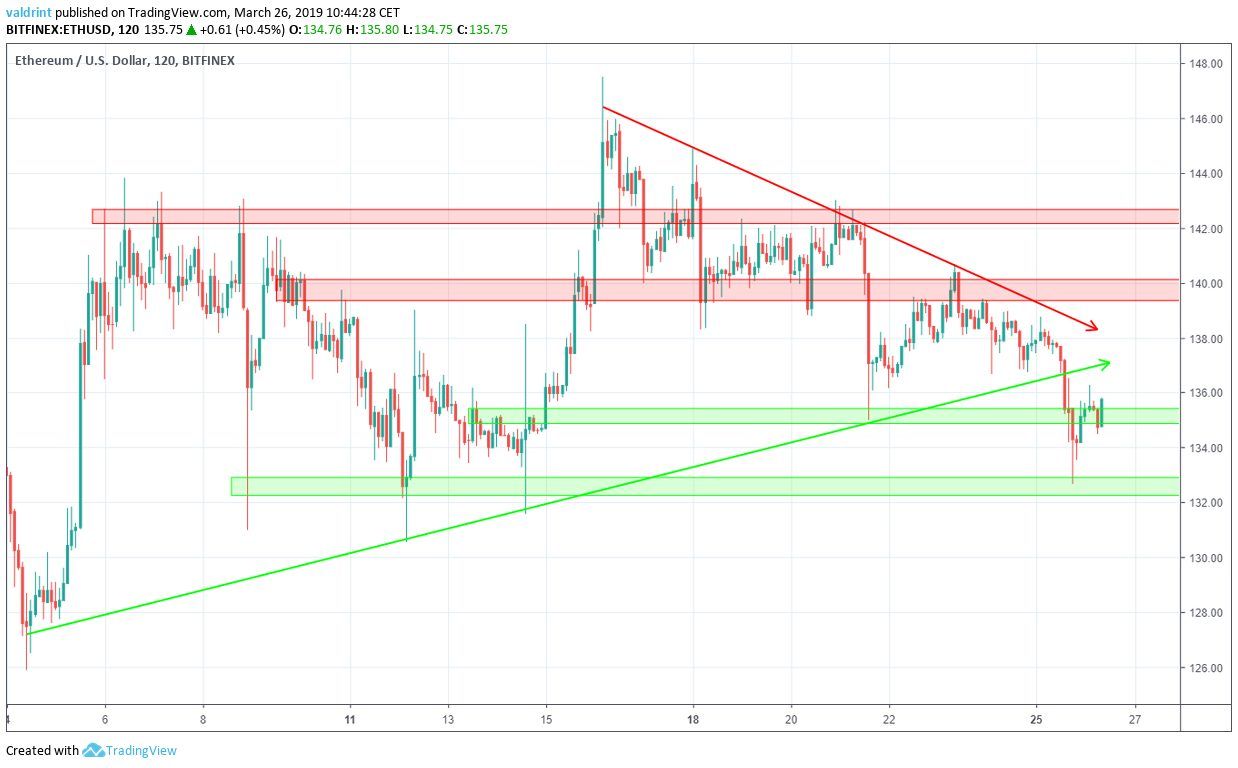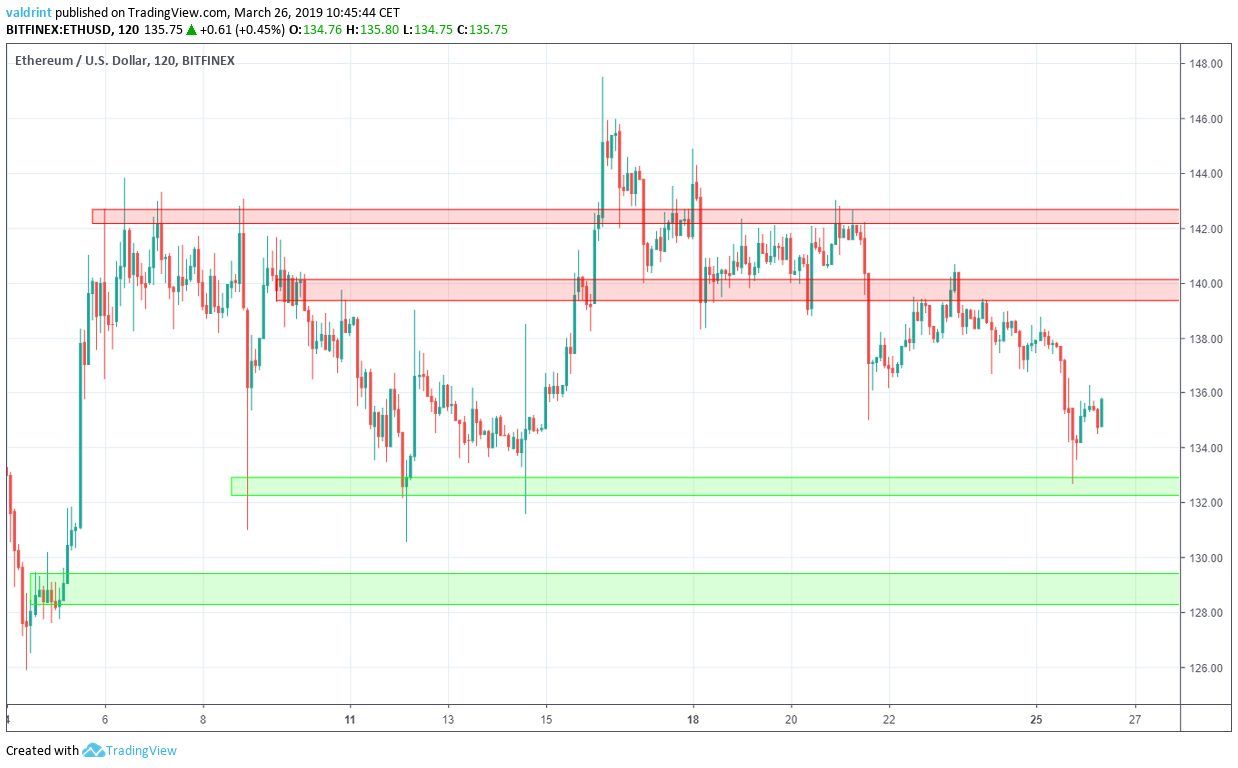At BeInCrypto, we offer regular price analyses and predictions of the most popular and relevant cryptoassets. In our Mar 25 analysis of ETH, we predicted that the price will likely increase, and possibly break out of the pattern defined below. A surprise breakdown soon thereafter seemed to invalidate our prediction. However, prices have since been rising and may continue doing so. While the former trading pattern has converged making a breakout now impossible, Ethereum’s price might still rise to levels predicted in yesterday’s prediction.
On Mar 16, 2019, the price of Ethereum (ETH) made a high of $147.5. A downtrend ensued. There were periods of both gradual and sharp price losses. A bottom of $132.67 may have been reached on Mar 26.
Will Ethereum’s price keep dropping or should we be expecting a rebound?

Ethereum (ETH): Trends and Highlights for March 26, 2019
- The price of Ethereum has been on a downtrend since Mar 16.
- ETH is trading inside a descending channel.
- There is bullish divergence developing in the RSI and the MACD.
- There are resistance areas near $153 and $145.
- There are support areas near $134 and $128.
Previous Movement
In order to illustrate the previous movement, the price of ETH on Bitfinex was analyzed at two-hour intervals from Mar 4 to Mar 26. On Mar 16, the price made a high of $147.5 A gradual downtrend ensued, with each high being lower than the previous one. Tracing these highs gives us a descending resistance line. On Mar 4, the price made a low of $125.88. Since then, several market cycles have been completed, with each low being higher than the previous one. Tracing these lows gives us an ascending support line. The support and resistance lines combine to create a symmetrical triangle. This pattern is a better predictor of price fluctuations than resistance and support lines alone.
Ethereum broke down below the support of the triangle on Mar 25—shortly after our last analysis was written.
This triangle is no longer an accurate indicator of future prices for two primary reasons:
The support and resistance lines combine to create a symmetrical triangle. This pattern is a better predictor of price fluctuations than resistance and support lines alone.
Ethereum broke down below the support of the triangle on Mar 25—shortly after our last analysis was written.
This triangle is no longer an accurate indicator of future prices for two primary reasons:
- The point of convergence between the support and resistance is likely to be reached in the very near future.
- The breakdown below the support suggests the emergence of new trading patterns independently of the triangle’s convergence.
Tracing Resistance
We trace the resistance line by analyzing the price of ETH on Bitfinex at one-hour intervals from Mar 13 to Mar 26. On Mar 16, the price made a high of $147.5. A gradual downward move followed. Several market cycles have been completed and each high has been lower than the previous one. Tracing these highs starting with the Mar 16 highs gives us the descending resistance line seen in the triangle above:Descending Channel
Now that the resistance line is defined, we trace the support to complete the trading pattern. On Mar 18, the price made a low of $138.3. A gradual increase was followed by a sharp decrease. Each low has been lower than the previous one. Tracing these lows beginning with the Mar 18 low gives us an ascending support line. Couple with resistance, we see that the triangle defined above has now emerged into a downward facing horizontal channel:Looking Out For Divergence
Combining MACD and RSI bullish/bearish divergence with support/resistance essentially predicts price fluctuations. The moving average convergence divergence (MACD) is a trend indicator that shows the relationship between two moving averages (long and short-term) and the price. It is used to measure the strength of a move. The relative strength index (RSI) is an indicator which calculates the size of the changes in price in order to determine oversold or overbought conditions in the market.Reversal Areas
The price of ETH on Bitfinex was analyzed at two-hour intervals from Mar 5 to Mar 26 to determine possible highs and lows that may be experienced within the channel. We also assess values that may be reached given a breakout or breakdown. Resistance and support areas are created when the price revisits the same level several times. The first resistance area is located near $140. A second, main resistance area is found near $145. Both of these are above the resistance line. Neither is expected to be reached except in the case of a surprise breakout—which we don’t believe to be likely.
The closest support area is found near $133 and is currently within the channel. It is also higher than the low experienced on Mar 26. This means that the first support has already been reached and is likely to be reached again.
A second support is area is found near $128. Currently, this support is below the channel and would only be reached in a breakdown. However, as the channel continues moving downward, it may eventually reach the $128 level. In such an instance, lows under $130 remain possible along the current trend without a significant breakdown below support.
The first resistance area is located near $140. A second, main resistance area is found near $145. Both of these are above the resistance line. Neither is expected to be reached except in the case of a surprise breakout—which we don’t believe to be likely.
The closest support area is found near $133 and is currently within the channel. It is also higher than the low experienced on Mar 26. This means that the first support has already been reached and is likely to be reached again.
A second support is area is found near $128. Currently, this support is below the channel and would only be reached in a breakdown. However, as the channel continues moving downward, it may eventually reach the $128 level. In such an instance, lows under $130 remain possible along the current trend without a significant breakdown below support.
Summary of Analysis
Based on this analysis, the price of ETH may increase and touch the resistance line of the channel. However, we do not believe a breakout is likely. On the contrary, gradual price decreases should continue. Lows under $130 may be reached by the end of March as long as the trading pattern remains an accurate indicator of future prices. If the price touches the resistance line, this prediction will be partially validated. If it decreases and falls to the support line after, it will be fully validated. This prediction would be invalidated by a breakout above the resistance line of the channel. Do you think ETH will keep trading inside the channel? Let us know your thoughts in the comments below. Disclaimer: This article is not trading advice and should not be construed as such. Always consult a trained financial professional before investing in cryptocurrencies, as the market is particularly volatile.Disclaimer
In line with the Trust Project guidelines, this price analysis article is for informational purposes only and should not be considered financial or investment advice. BeInCrypto is committed to accurate, unbiased reporting, but market conditions are subject to change without notice. Always conduct your own research and consult with a professional before making any financial decisions. Please note that our Terms and Conditions, Privacy Policy, and Disclaimers have been updated.

Valdrin Tahiri
Valdrin discovered cryptocurrencies while he was getting his MSc in Financial Markets from the Barcelona School of Economics. Shortly after graduating, he began writing for several different cryptocurrency related websites as a freelancer before eventually taking on the role of BeInCrypto's Senior Analyst.
(I do not have a discord and will not contact you first there. Beware of scammers)
Valdrin discovered cryptocurrencies while he was getting his MSc in Financial Markets from the Barcelona School of Economics. Shortly after graduating, he began writing for several different cryptocurrency related websites as a freelancer before eventually taking on the role of BeInCrypto's Senior Analyst.
(I do not have a discord and will not contact you first there. Beware of scammers)
READ FULL BIO
Sponsored
Sponsored




